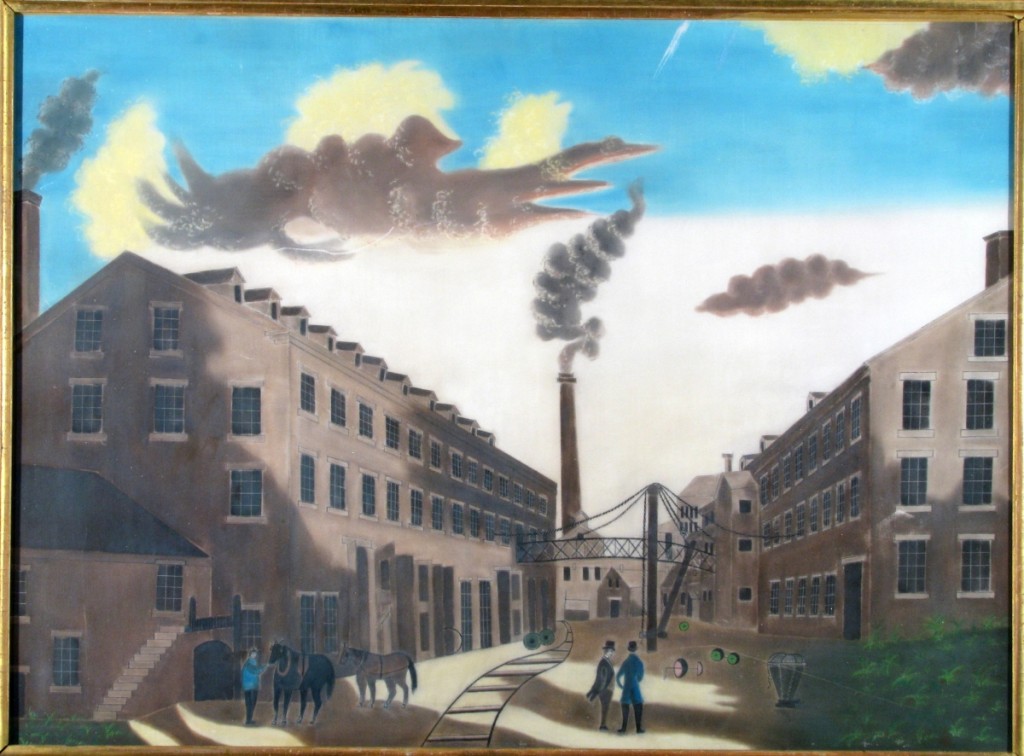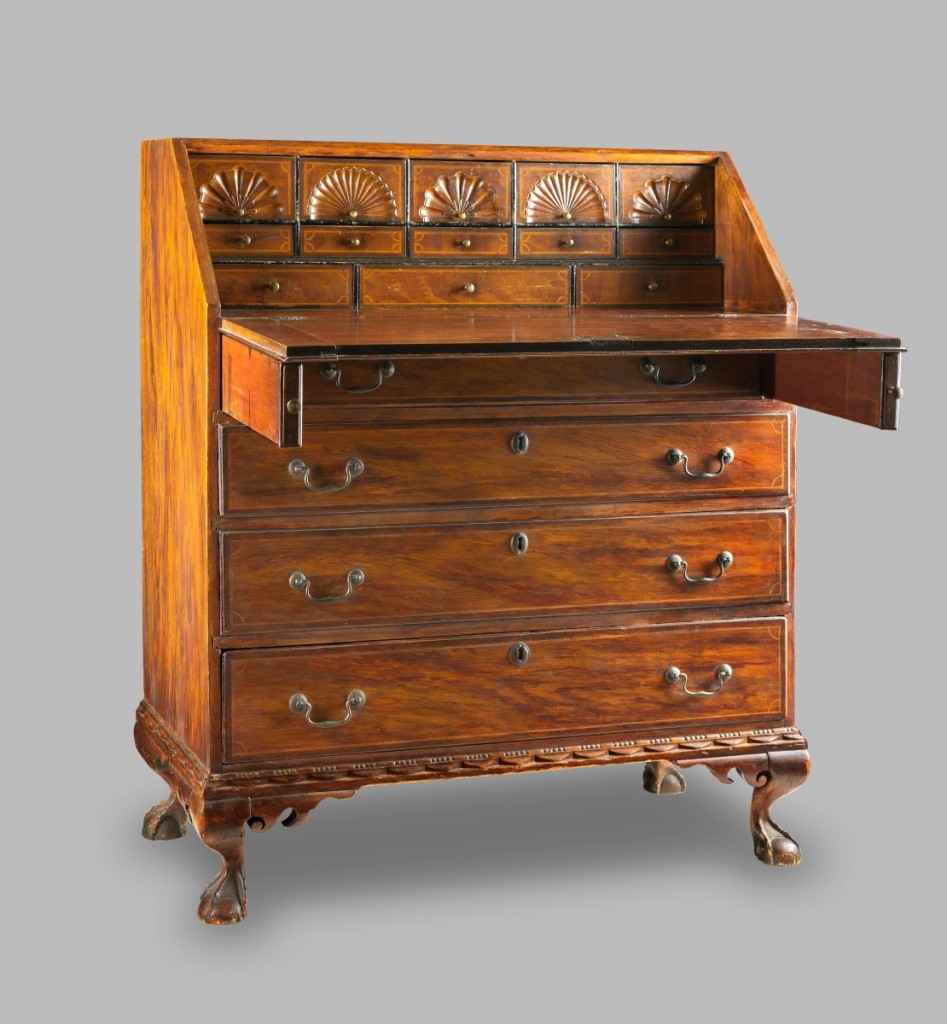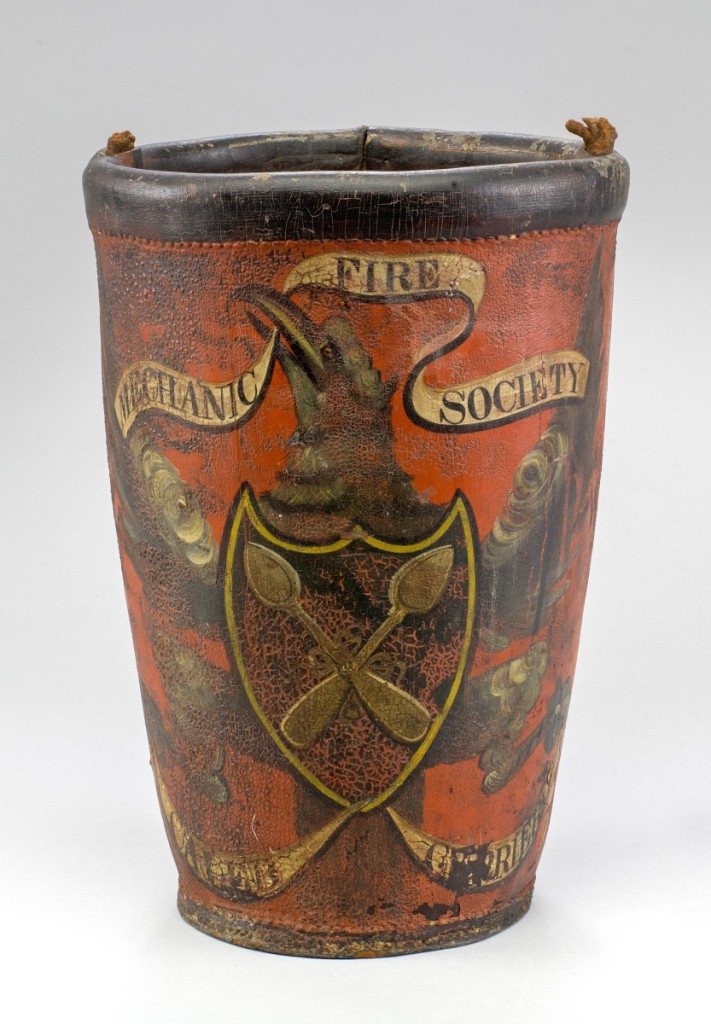
“View of Amoskeag Millyard,” attributed to James B. Baker, circa 1840. Pastel; 18 by 25 inches. Manchester Historic Association. —TK photo
Review by Rick Russack
PORTSMOUTH, N.H. – The term “folk art” is broad and refining it to New Hampshire doesn’t really narrow it much. A wide-ranging exhibit of folk art made or used in New Hampshire will continue through September 29, at Discover Portsmouth, in the heart of downtown Portsmouth. It will include about 75 objects demonstrating the diversity of folk art made by and enjoyed by the “common people” in the area from the seacoast to the White Mountains and beyond.
Several works by identified, but little-known artists, will be on display. The core of the exhibition will be portraits and landscapes, as well as carvings, hooked rugs, fireboards, trade signs and furniture, as well as everyday objects made special by the time and care an anonymous artist devoted to embellishing them. There will also be a fanciful map of the White Mountains, a birch bark creation by “Birch Bark” Merrill, decoys by George Boyd and others, penmanship and drawing skills will be illustrated by the works of John Montgomery, a teacher in Portsmouth’s public schools, scrimshaw, fire buckets and more. Objects made throughout a 300-year period are featured, including a pink pussyhat made in Portsmouth and worn during the Women’s March in Washington DC in 2017.
While the origins of the early settlers in the area we now call New Hampshire were British, Irish and Scottish, there were also large populations of African Americans, French Canadians, Greeks and Italians. More recently, immigrants from Turkey, Iraq, Somalia and other parts of the world, have added their traditions to those of the early settlers.
On display will be several paintings, portraits, landscape and city views and fireboards by unidentified or little-known artists. Some scenes are identified, such as a view of the Amoskeag mill yard attributed to James B. Baker and a view of West Lebanon, N.H., by Almira B. Simons. One of the lesser known New Hampshire artists is Caroline Hill (1816-1854); the artist depicted herself along with her family in a house on Summer Street in Peterborough, N.H., in her “Job Hill and His Family,” which is dated 1837. An unusual feature is that she included the family register hanging on the wall behind the sitters. As often happened in that period, Caroline and her several sisters worked in the local Peterborough textile mills to help pay for their brother’s education.
An 1888 landscape of Garrison Hill in Dover, N.H., is by an unidentified artist. According to records in Dover’s Woodman Museum, the artist was “an unknown teenage boy who painted it from his sickroom window in a house on Hill Street” in Dover. The unknown artist depicted several local landmarks, including at the top center, an observatory built in 1880. There are two wonderful albums, one of pen and ink sketches and one of watercolors by little known artists. One album, done by Rufus Patten (d 1879) includes a number of detailed miniature drawings done between 1825 and 1835. They are part of a group of works presumably done as youthful exercises in penmanship and drawing. Patten eventually served in the Civil War, was a justice of the peace and lived in Candia, N.H.

Desk, attributed to Samuel Dunlap (1752–1830), Henniker, N.H., late Eighteenth Century. Painted maple, white pine. Private collection.
Another album, with about 137 watercolors, documents street life in Portsmouth during the years of the Civil War. Done by James H. Head (circa 1830-1869) the album is titled The Floral Architect: Rules and Designs for Processions Portsmouth, circa 1861-65. Head, once a well-known artistic figure in Portsmouth, is best known today for this book of watercolors; a wonderful compilation of plates depicting an enormous variety of street processions, floats, decorated buildings and other scenes. Some of his images may reflect actual parades or events, while others may be fanciful or imaginary. Taken together, they provide a fascinating glimpse of street life, real and imagined, during the Civil War. A particularly striking fireboard by an unknown artist displays a rather happy looking lion from a home in the Piermont, N.H., area, circa 1825.
In addition to the works of lesser-known artists, works by well-known artists with New Hampshire connections include Ruth W. Shute, Joseph Davis, Zedekiah Belknap, Rufus Porter and others. There are two silhouettes done in Portsmouth by William Chamberlain (active circa 1820). A pair of unsigned portraits by itinerant artist Joseph Stone (1774-1818) depict Joseph Mills, an officer during the Revolution, who was also one of the early members of the New Hampshire chapter of the Society of the Cincinnati, and his wife. Based on research by Arthur Kern, they are attributed to Stone, once known only as the “painter of the almond-shaped eyes.”
A portrait by one of the few known husband and wife itinerant artist teams, Ruth Whitter Shute (1803-1882) and her husband, Samuel Addison Shute (1804-1836), is a likeness of Sarah Whitmarsh, painted in Milford, N.H., on March 25, 1833. So is another of their works depicting a husband and wife from Hopkinton, N.H. Characteristic of the best work of Joseph H. Davis (active 1832-1837) is a pair of portraits of a husband and wife of Brookfield, N.H. Each sitter is in fine clothing, standing on colorful carpets, and calligraphic legends identify and date the images.
New Hampshire carving and furniture making skills are demonstrated by four pieces of furniture made by members of the Dunlap family, together with seven decoys by New Hampshire master George Boyd (1873-1941) and six by Edward H. Adams (1860-1951), who for years worked at various jobs on the Piscataqua River. A painted pine mermaid, done in the Lake Sunapee area in the 1920s by an anonymous carver, is also included. Not all was wood. A circa 1850-60 marble carving of a lion and a lamb, perhaps inspired by Edward Hicks’ many paintings of The Peaceable Kingdom, is signed “Treat.” Several generations of the Treat family operated The Portsmouth Marble Company throughout much of the Nineteenth Century.
Contemporary works by members of the League of New Hampshire Craftsmen demonstrate that woodcarving skills are alive and well, with decoys by Fred Dolan, one of the state’s contemporary master carvers. Dolan has won numerous awards for his decoys, including awards from the Smithsonian Museum. The first carving acquired by the league for their collection, will also be on display here; a spotted fawn by Archie Gilbert (1868-1947), who lived and worked in Landaff, N.H., and this piece was made about 1932.

Attributed to John S. Blunt (1798–1835), inscribed “Firebucket owned by Caleb Currier,” Portsmouth, circa 1825. Painted leather; 12 inches high, 8¼ inches diameter. Portsmouth Historical Society; Gift of Mrs Alice Vaughn Johnson.
In the last few years, exhibitions mounted by the Portsmouth Historical Society, such as this one, have included examples of related works by contemporary artists. In conjunction with this exhibit, the upstairs galleries will include several works by members of the League of New Hampshire Craftsmen. Although these artists and craftsmen are academically trained, their work is usually handmade and reflects the traditional methods and materials of earlier years. Together, the exhibits provide a long view of “folk art” across a wide period of time.
Nearly 50 objects in the show are illustrated in the color catalog, which has an extensive introduction by Gerald W.R. Ward, consulting curator at the Portsmouth Historical Society and for more than 13 years, curator of American decorative arts at Boston’s Museum of Fine Arts. Ward has authored, or co-authored, numerous books and articles on American furniture and crafts.
The League of New Hampshire Craftsmen can trace its lineage at least back to 1932. It has always supported contemporary and traditional crafts and today has more than 750 juried craftspeople producing exceptional contemporary and traditional craft in a wide range of media, from baskets and pottery to printmaking and wood, from jewelry and quilts to photography and folk art. Works by many of their members will be on display as part of this exhibition. Their nine-day annual craft fair at the Mount Sunapee Resort is scheduled for the first week of August, which coincides with Antiques Week in New Hampshire and will allow interested visitors to easily investigate the full range of crafts and view numerous live demonstrations. More than 30,000 people attended last year’s fair.
Discover Portsmouth is operated by the Portsmouth Historical Society, which annually presents such significant exhibits, and owns and operates the nearby John Paul Jones House Museum and Garden, a National Historic Landmark. Jones, an early Commander in the Continental Navy and sometimes called the “The Father of The American Navy,” lived in the house in 1781 while he was supervising the construction of the Navy’s ship America in the nearby Portsmouth Naval Shipyard. The Portsmouth Historical Society also offers several guided walking tours of Portsmouth which discuss the history and architecture of the city. The society also draws about 30,000 visitors annually. One can easily spend a day or two, or more, in the city, as there are seven other historical house museums, all furnished, as well as Strawberry Banke, with 37 additional houses that demonstrate life on Portsmouth’s waterfront from 1695 to 1954.
Discover Portsmouth is at 10 Middle Street. For additional information, 603-436-8433 or www.portsmouthhistory.org.



























